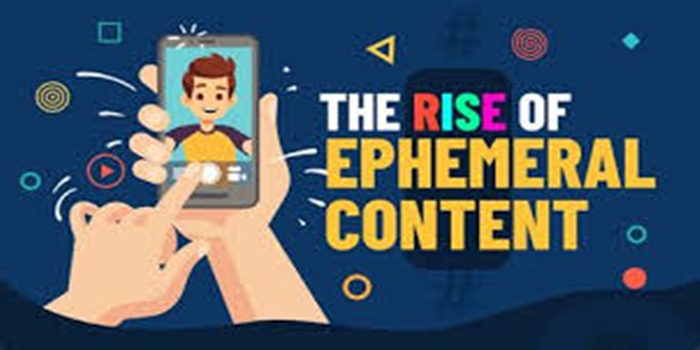In this article, we discussed the meaning of ephemeral marketing, the features, we also talked about the examples and benefits.
Definition
The Rise of Ephemeral Marketing refers to the growing acceptance and effectiveness of using temporary or limited-time content in marketing strategies, particularly on social media
The Features of the Rise Ephemeral Marketing:
Increased Engagement:
The temporary nature of ephemeral content encourages users to interact with it immediately, boosting engagement rates.
Sense of Urgency and FOMO:
The limited availability creates a sense of urgency and FOMO, motivating users to seek out and engage with the content while it’s available.
Authenticity and Spontaneity:
Ephemeral content often feels more authentic and spontaneous compared to traditional advertising, fostering a closer connection with the audience.
Interactivity:
Platforms often offer interactive features within ephemeral content, such as polls, quizzes, and Q&A sessions, further engaging users.
Strategic Timing and Content Creation:
The temporary nature of ephemeral content allows for more strategic planning and timing of content creation, maximizing its impact during specific periods.
Versatility:
Ephemeral content can be used for various marketing purposes, including showcasing products, promotions, exclusive content, and behind-the-scenes looks. Examples of Ephemeral Marketing:
Snapchat:
Known for disappearing messages and Stories, Snapchat’s geofilters encourage location-based engagement.
Instagram:
Stories and Reels provide a platform for quick, temporary content, often used for daily updates or flash sales.
Facebook:
Stories and My Day features offer users the ability to share content that disappears after 24 hours.
TikTok:
Short-form video clips and viral trends are often ephemeral, driving engagement and creating a sense of urgency.
WhatsApp:
Disappearing messages and short videos on profiles are examples of ephemeral content.
The Benefits of Ephemeral Marketing:
- Increased Engagement and Interaction:
Ephemeral content, like stories on social media platforms, often includes features like polls, quizzes, and questions, prompting users to actively participate.
The temporary nature of the content creates a sense of urgency, encouraging users to engage quickly, leading to higher engagement rates.
- Authenticity and Relatability:
Ephemeral content often captures behind-the-scenes moments, day-to-day activities, and real-time updates, giving followers a glimpse into the brand’s personality and culture.
This informal approach can make a brand feel more human and relatable, building trust and connection with the audience.
- Leveraging FOMO:
The temporary nature of ephemeral content creates a sense of urgency, making users feel like they might miss out if they don’t engage immediately.
This can lead to increased engagement and a stronger recall of the brand.
- Quick and Real-Time Engagement:
They allows for instant responses to trends, audience inquiries, or even real-time updates from events.
This immediacy fosters a stronger sense of connection and allows for more direct, two-way communication with the audience.
- Brand Visibility and Trust:
They can help to increase brand visibility and build trust by offering a behind-the-scenes look into the brand’s operations.
It can also demonstrate the brand’s ability to be spontaneous and responsive to current trends.
- Cost-Effectiveness and Flexibility:
It content allows for more flexible and less expensive content creation, as there’s less pressure to create perfectly polished pieces.
This allows for more frequent content creation and a greater ability to respond to real-time events and trends.
Conclusion
The Rise of Ephemeral Marketing” refers to the growing popularity and effectiveness of using temporary or limited-time content in marketing strategies, particularly on social media. This trend leverages the appeal of short-lived content to create a sense of urgency, and increased engagement. Platforms like Snapchat and Instagram Stories have popularized this approach, with content designed to disappear after a short period, often within 24 hours.
READ: Understanding Ephemeral Content


